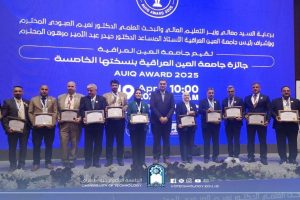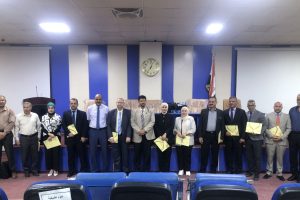
Graduate Student from the Branch of Medical and Industrial Materials Science Earns a Master’s Degree for Research on Enhancing Denture Base Properties Using Nanoparticles
The Branch of Medical and Industrial Materials Science awarded a Master’s degree to the graduate student Iman Alwan Arhim for her thesis titled:
“Improvement of Mechanical and Antimicrobial Properties of Denture Base by Adding Nanoparticle Materials”
The defence was held in the late Professor Dr Abdul-Muttalib Ibrahim Al-Sheikh Hall at the department building. The Examination Committee consists of:
- Prof. Dr. Ali Abadi Al-Taif
Department of Applied Sciences / Medical and Industrial Materials Science Branch – Chair - Asst. Prof. Dr. Athraa Ali Mahmoud
Al-Mustansiriya University / College of Dentistry – Member - Lect. Dr. Mohammed Salman Kazem
Department of Applied Sciences / Laser Science and Technology Branch – Member - Lect. Dr. Manal Abdulwahid Aboud
Department of Applied Sciences / Medical and Industrial Materials Science Branch – Member & Supervisor - Dr. Halima Thajeel Halboos
Ministry of Science and Technology / Materials Research Directorate – Member & Supervisor
In this study, the effect of incorporating nanoparticles (silver, titanium oxide, and zirconium oxide) on certain mechanical properties (flexural strength, impact strength, surface hardness, compressive strength, and surface roughness) of polymethyl methacrylate (PMMA) used in denture fabrication was investigated. Additionally, the effect of nanoparticle incorporation on antimicrobial properties was examined.
The samples were divided into three groups based on the ratio of added nanoparticles (silver: titanium oxide and silver: zirconium oxide). A fixed weight percentage of 0.3% silver nanoparticles was added, while titanium oxide and zirconium oxide were added at weight percentages of (0.1%, 0.3%, 0.5%). Furthermore, a third group of samples was prepared with 0.3% silver and (0.05%, 0.15%, 0.25%) of both titanium oxide and zirconium oxide to study the combined effect of nanoparticles on the properties of PMMA. The structural properties of the nanoparticles were examined using X-ray diffraction (XRD), and surface morphology was analyzed using field emission scanning electron microscopy (FESEM). Surface roughness was evaluated using an atomic force microscope (AFM).
The incorporation of silver and titanium oxide nanoparticles increased the flexural strength, with the highest value recorded at (76.62 MPa) for 0.3% Ag + 0.3% TiO₂. Meanwhile, adding ZrO₂ resulted in a slight improvement, reaching (71.83 MPa) at 0.5% ZrO₂. The highest flexural strength was achieved when combining nanoparticles, reaching (89.35 MPa) at 0.3% Ag + 0.15% (TiO₂-ZrO₂). Surface hardness increased for all samples upon nanoparticle addition, reaching the highest values of (85.3) and (85.5) at 0.3% Ag + 0.3% TiO₂ and 0.3% Ag + 0.5% ZrO₂, respectively, compared to (81.2) for pure PMMA.
The impact strength was enhanced by silver and titanium oxide nanoparticles, reaching a maximum of (7.54 kJ/m²) at 0.3% Ag + 0.3% TiO₂, compared to (6.81 kJ/m²) for PMMA. A similar effect was observed with the combined nanoparticles, with the highest value of (7.14 kJ/m²) at 0.3% Ag + 0.15% (TiO₂-ZrO₂). However, the addition of zirconium oxide decreased impact strength, with the lowest value recorded at (5.49 kJ/m²) for 0.1% ZrO₂.Compressive strength increased with nanoparticle addition, with the highest value of (147.07 MPa) at 0.3% Ag + 0.5% ZrO₂, followed by (132.3 MPa) at 0.3% Ag + 0.5% TiO₂, compared to (98.01 MPa) for pure PMMA. Young’s modulus decreased with increasing nanoparticle conIn this study, the effect of incorporating nanoparticles (silver, titanium oxide, and zirconium oxide) on some mechanical properties—flexural strength, impact strength, surface hardness, compressive strength, and surface roughness—of polymethyl methacrylate (PMMA) used in denture fabrication, was investigated. Additionally, the effect of nanoparticle incorporation on antimicrobial properties was examined. The samples were divided into three groups based on the nanoparticle addition ratio: (silver: titanium oxide) and (silver: zirconium oxide). A fixed weight percentage (0.3%) of silver nanoparticles was added, while titanium oxide and zirconium oxide were added in varying proportions (0.1%, 0.3%, and 0.5%). Moreover, a third group of samples was prepared, incorporating 0.3% silver and (0.05%, 0.15%, 0.25%) of both titanium oxide and zirconium oxide to study the combined effect of nanoparticles on PMMA properties. X-ray diffraction (XRD) was used to analyze the structural properties of the nanoparticles. Additionally, surface morphology was examined using a field emission scanning electron microscope (FESEM), while an atomic force microscope (AFM) was employed to assess surface roughness. The results showed that incorporating silver and titanium oxide nanoparticles enhanced the flexural strength, with the highest value (76.62 MPa) observed at 0.3% Ag + 0.3% TiO2. Meanwhile, adding ZrO2 resulted in a slight improvement, reaching (71.83 MPa) at 0.5% ZrO2. The combination of nanoparticles yielded the highest flexural strength value (89.35 MPa) at 0.3% Ag + 0.15% (TiO2 – ZrO2). Surface hardness increased for all samples with nanoparticle incorporation, reaching peak values of (85.3) and (85.5) at 0.3% Ag + 0.3% TiO2 and 0.3% Ag + 0.5% ZrO2, respectively, compared to (81.2) for pure PMMA, adding silver and titanium oxide improved impact strength, achieving the highest value (7.54 kJ/m²) at 0.3% Ag + 0.3% TiO2, compared to (6.81 kJ/m²) for PMMA. A similar trend was observed when combined nanoparticles, with the highest impact strength (7.14 kJ/m²) at 0.3% Ag + 0.15% (TiO2 – ZrO2). However, ZrO2 addition reduced impact strength at all concentrations, with the lowest value (5.49 kJ/m²) recorded at 0.1% ZrO2. The results showed that compressive strength increased with nanoparticle incorporation, with the highest value (147.07 MPa) observed at 0.3% Ag + 0.5% ZrO2, followed by (132.3 MPa) at 0.3% Ag + 0.5% TiO2, compared to (98.01 MPa) for PMMA. However, Young’s modulus decreased with increasing nanoparticle concentration, with the lowest value (415.18 MPa) recorded at 0.3% Ag + 0.25% (TiO2 – ZrO2), compared to (616.44 MPa) for PMMA. Surface roughness significantly improved with nanoparticle incorporation, with the best value (0.2917 µm) observed at 0.3% Ag + 0.3% TiO2, compared to (0.7556 µm) for PMMA, followed by (0.3453 µm) at 0.3% Ag + 0.3% ZrO2.The antimicrobial activity study revealed that adding 0.3% Ag + 0.25% (TiO2 – ZrO2) exhibited the highest microbial inhibition. Furthermore, the inhibitory effect against Streptococcus mutans was more significant than its effect against Escherichia coli at all tested concentrations.centrations, with the lowest value recorded at (415.18 MPa) for 0.3% Ag + 0.25% (TiO₂-ZrO₂), compared to (616.44 MPa) for PMMA.Surface roughness significantly improved with nanoparticle incorporation, with the best value recorded at 0.3% Ag + 0.3% TiO₂ (0.2917 µm) compared to (0.7556 µm) for PMMA, followed by (0.3453 µm) at 0.3% Ag + 0.3% ZrO₂. Antimicrobial activity results showed that 0.3% Ag + 0.25% (TiO₂-ZrO₂) exhibited the highest microbial inhibition. Additionally, the antimicrobial effect was more pronounced against Streptococcus mutans compared to Escherichia coli at all concentrations.



